Regional Features and National Differences in Population Distribution in China’s Border Regions (2000–2015)
Abstract
:1. Introduction
2. Materials and Methods
2.1. Data Selection and Processing
2.2. Research Methods
2.2.1. Geographical Range Definition of China’s Border Regions
2.2.2. Population Agglomeration Index
2.2.3. Relative Population Change
3. Results
3.1. The Basic Population Distribution in China’s Border Areas
3.2. Comparative Analysis of Population Distribution in China’s Border Areas
3.3. Geographic Changes in Population Distribution in China’s Border Areas
4. Discussion
5. Conclusions
Acknowledgments
Author Contributions
Conflicts of Interest
References
- Wong, W.C.; Wang, Y.L. A qualitative study on HIV risk behaviors and medical needs of sex workers in a China/Myanmar border town. AIDS Patient Care STDs 2003, 17, 417–422. [Google Scholar] [CrossRef] [PubMed] [Green Version]
- Shneiderman, S.B. Himalayan border citizens: Sovereignty and mobility in the Nepal–Tibetan Autonomous Region (TAR) of China border zone. Political Geogr. 2013, 35, 25–36. [Google Scholar] [CrossRef]
- Des Jarlais, D.C.; Kling, R.; Hammett, T.M.; Ngu, D.; Liu, W.; Chen, Y.; Binh, K.T.; Friedmann, P. Reducing HIV infection among new injecting drug users in the China-Vietnam Cross Border Project. AIDS 2007, 21, 109–114. [Google Scholar] [CrossRef] [PubMed]
- Liu, X.; Jiang, L.; Feng, Z.; Li, P. Rubber Plantation Expansion Related Land Use Change along the Laos-China Border Region. Sustainability 2016, 8, 1011. [Google Scholar] [CrossRef]
- Chanhda, H.; Wu, C.F.; Ye, Y.M.; Ayumi, Y. GIS based land suitability assessment along Laos-China border. J. For. Res. 2010, 21, 343–349. [Google Scholar] [CrossRef]
- Socquet, A.; Pubellier, M. Cenozoic deformation in western Yunnan (China-Myanmar border). J. Asian Earth Sci. 2005, 24, 495–515. [Google Scholar] [CrossRef]
- Meng, Q.R.; Hu, J.M.; Jin, J.Q.; Zhang, Y.; Xu, D.F. Tectonics of the late Mesozoic wide extensional basin system in the China-Mongolia border region. Basin Res. 2003, 15, 397–415. [Google Scholar] [CrossRef]
- Wang, T.; Zheng, Y.; Li, T.; Gao, Y. Mesozoic granitic magmatism in extensional tectonics near the Mongolian border in China and its implications for crustal growth. J. Asian Earth Sci. 2004, 23, 715–729. [Google Scholar] [CrossRef]
- Feng, Z.; Liu, X.; Jiang, L.; Li, P. Spatial-temporal analysis of rubber plantation and its relationship with topographical factors in the border region of China, Laos and Myanmar. Acta Geogr. Sin. 2013, 68, 1432–1446. [Google Scholar]
- You, Z.; Yang, Y.; Jiang, L.; Feng, Z.; Zhang, J. The study on the relief degree of land surface in the Lancang-Mekong River Basin. J. Yunan Univ. 2012, 34, 393–400. (In Chinese) [Google Scholar]
- Iwashita, A. The influence of local Russian intiatives on relations with China: Border demarcation and regional partnership. Acta Slavica Iaponica 2002, 19, 1–18. [Google Scholar]
- Luân, V.Đ. Contested Sovereignty: Local Politics and State Power in Territorial Conflicts on the Vietnam-China Border, 1650s–1880s. Cross Curr. East Asian Hist. Cult. Rev. 2016, 5, 497–533. [Google Scholar] [CrossRef]
- Xiaosong, G.; Womack, B. Border cooperation between China and Vietnam in the 1990s. Asian Surv. 2000, 40, 1042–1058. [Google Scholar] [CrossRef]
- Womack, B. China’s border trade and its relationship to the national political economy. Am. Asian Rev. 2001, 19, 31–48. [Google Scholar]
- Nijman, V.; Shepherd, C.R.; Nekaris, A.I. Trade in Bengal Slow Lorises in Mong La, Myanmar, on the China Border. Prim. Conserv. 2014, 28, 139–142. [Google Scholar] [CrossRef]
- Schoenberger, L.; Turner, S. Negotiating remote borderland access: Small-scale trade on the Vietnam-China border. Dev. Chang. 2008, 39, 667–696. [Google Scholar] [CrossRef]
- Nijman, V.; Shepherd, C.R. Emergence of Mong La on the Myanmar-China border as a global hub for the international trade in ivory and elephant parts. Biol. Conserv. 2014, 179, 17–22. [Google Scholar] [CrossRef]
- Alff, H. Getting stuck within flows: Limited interaction and peripheralization at the Kazakhstan–China border. Cent. Asian Surv. 2016, 35, 369–386. [Google Scholar] [CrossRef]
- Newman, D.; Paasi, A. Fences and Neighbours in the Postmodern World: Boundary Narratives in Political Geography. Prog. Hum. Geogr. 1998, 22, 186–207. [Google Scholar] [CrossRef]
- Zhou, X.; Li, S.; Wang, J.; Huang, J.; Zhou, H.; Chen, J.; Zhou, X. Emergence of human babesiosis along the border of China with Myanmar: Detection by PCR and confirmation by sequencing. Emerg. Microbes Infect. 2014, 3, e55. [Google Scholar] [CrossRef] [PubMed]
- Kato, K.; Kusagawa, S.; Motomura, K.; Yang, R.; Shiino, T.; Nohtomi, K.; Sato, H.; Shibamura, K.; Hien, N.T.; Chi, P.K.; et al. Closely related HIV-1 CRF01_AE variant among injecting drug users in northern Vietnam: Evidence of HIV spread across the Vietnam-China border. AIDS Res. Hum. Retrovir. 2001, 17, 113–123. [Google Scholar] [CrossRef] [PubMed]
- Hill, A.M. Border Landscapes: The politics of Akha land use in China and Thailand. China Rev. Int. 2007, 14, 554–557. [Google Scholar] [CrossRef]
- Endres, K.W. Making Law: Small-scale trade and corrupt exceptions at the Vietnam-China border. Am. Anthropol. 2014, 116, 611–625. [Google Scholar] [CrossRef]
- Hammett, T.M.; Johnston, P.; Kling, R.; Liu, W.; Ngu, D.; Tung, N.D.; Binh, K.T.; Dong, H.V.; Hoang, T.V.; Van, L.K.; et al. Correlates of HIV status among injection drug users in a border region of southern China and northern Vietnam. J. Acquir. Immune Defic. Syndr. 2005, 38, 228–235. [Google Scholar] [CrossRef] [PubMed]
- Wang, R.; Dong, J.; Xia, Z.; Tao, C.; Zhang, Q.; Zhang, Y.; Tian, Y.; Sun, X.; Zhang, G.; Li, Q.; et al. Lessons on malaria control in the ethnic minority regions in Northern Myanmar along the China border, 2007–2014. Infect. Dis. Poverty 2016, 5, 95. [Google Scholar] [CrossRef] [PubMed]
- Lo, E.; Nguyen, J.; Oo, W.; Hemming-Schroeder, E.; Zhou, G.; Yang, Z.; Cui, L.; Yan, G. Examining Plasmodium falciparum and P. vivax clearance subsequent to antimalarial drug treatment in the Myanmar-China border area based on quantitative real-time polymerase chain reaction. BMC Infect. Dis. 2016, 16, 1–12. [Google Scholar] [CrossRef] [PubMed]
- Scheerer, H.; Hoche, H.; Broszeit, E.; Berger, C. Tribological properties of sputtered CrN coatings under dry sliding oscillation motion at elevated temperatures. Surf. Coat. Technol. 2001, 142, 1017–1022. [Google Scholar] [CrossRef]
- Lay, T.; Kanamori, H.; Ammon, C.J.; Nettles, M.; Ward, S.N.; Aster, R.C.; Beck, S.L.; Bilek, S.L.; Brudzinski, M.R.; Butler, R.; et al. The great Sumatra-Andaman earthquake of 26 December 2004. Science 2005, 308, 1127–1133. [Google Scholar] [CrossRef] [PubMed]
- The Research Group of Suitability of Population Distribution in China. Report on the Suitability of Population Distribution in China; Science Press: Beijing, China, 2014; pp. 214–215. [Google Scholar]
- Liu, R.; Feng, Z.; Yang, Y.; You, Z. Research on the Spatial Pattern of Population Agglomeration and Dispersion in China. Prog. Geogr. 2010, 29, 1171–1177. [Google Scholar]
- Li, F.; Feng, Z.; Li, P.; You, Z. Measuring directional urban spatial interaction in China: A migration perspective. PLoS ONE 2017, 12, e0171107. [Google Scholar] [CrossRef] [PubMed]
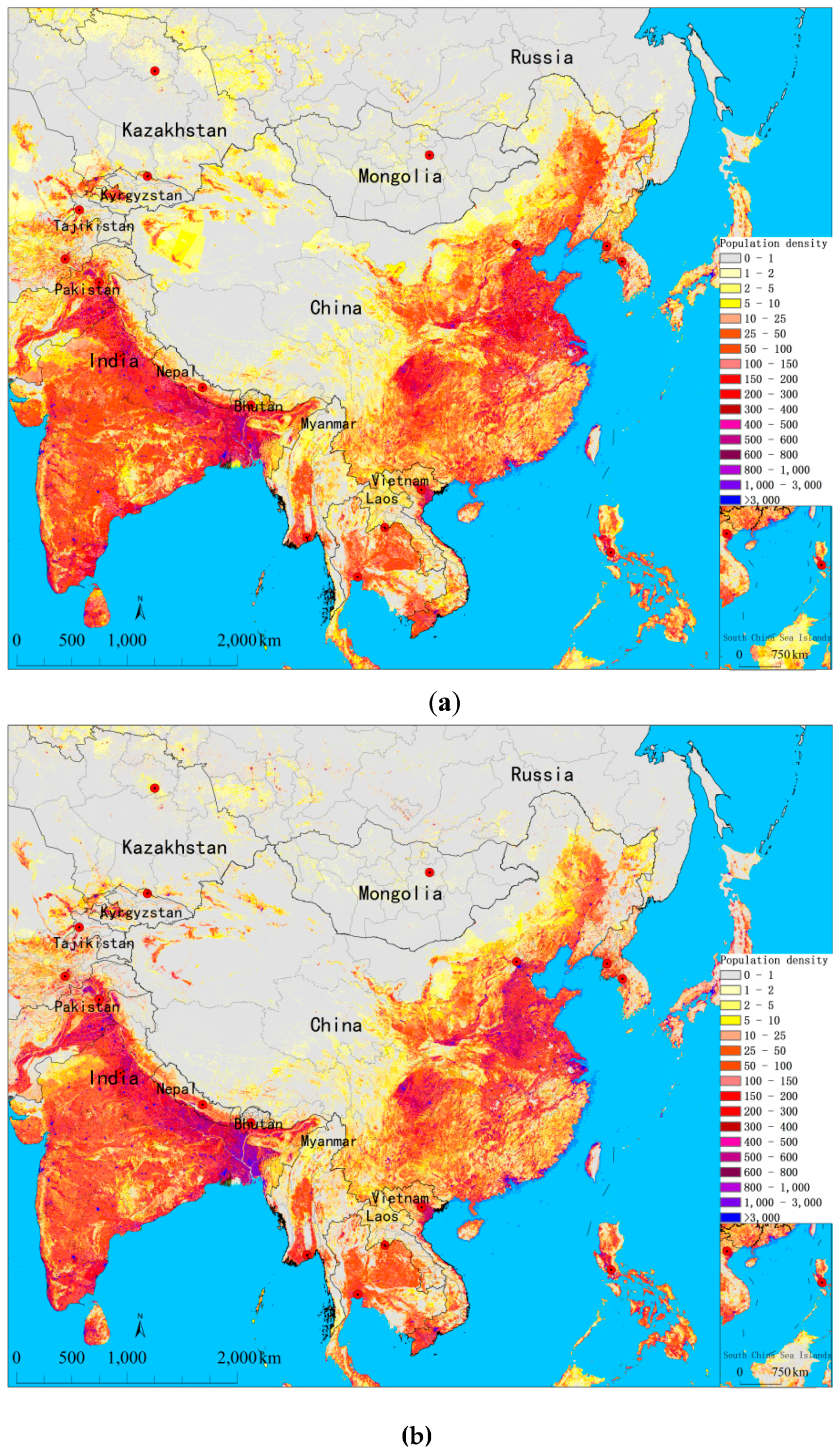
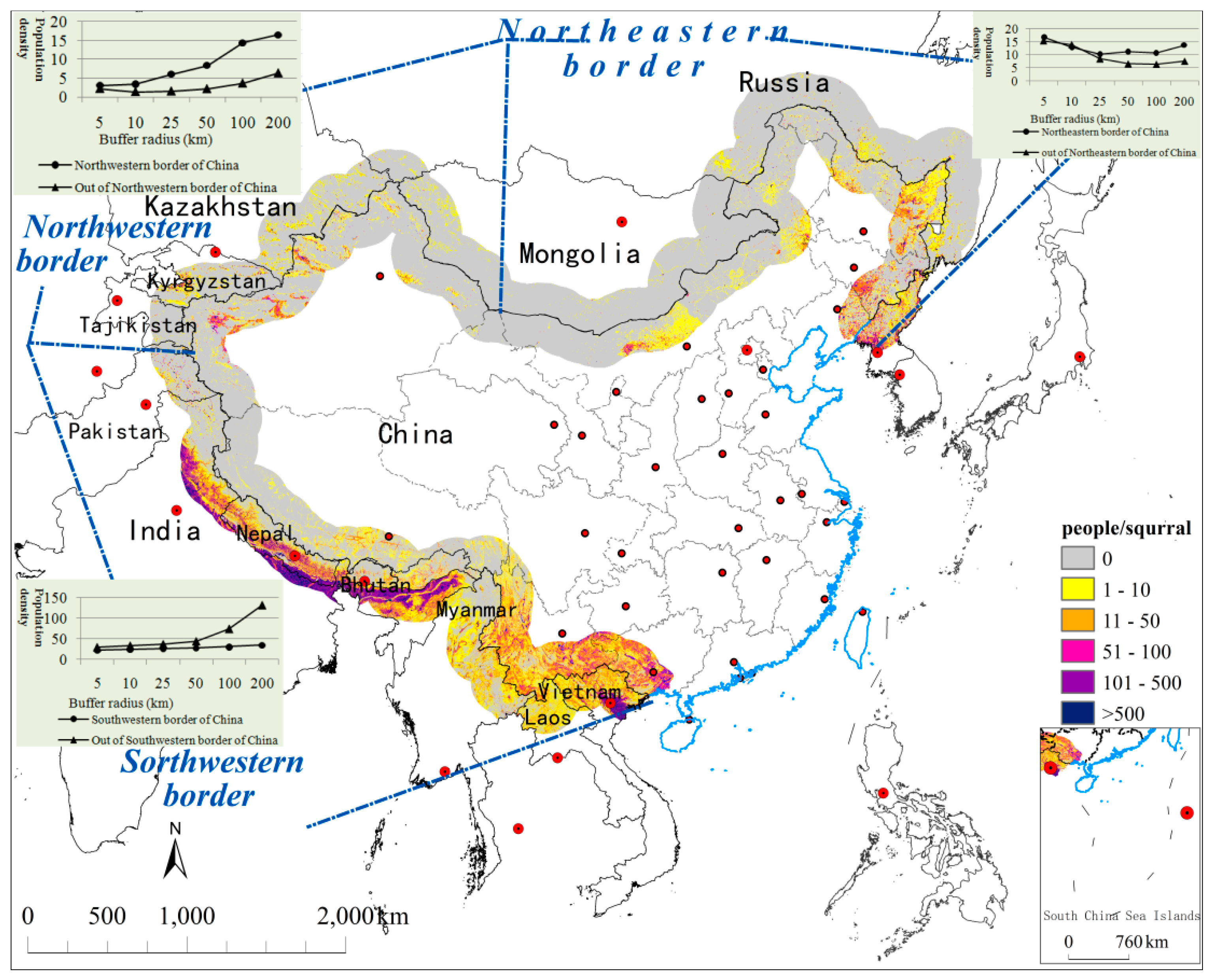
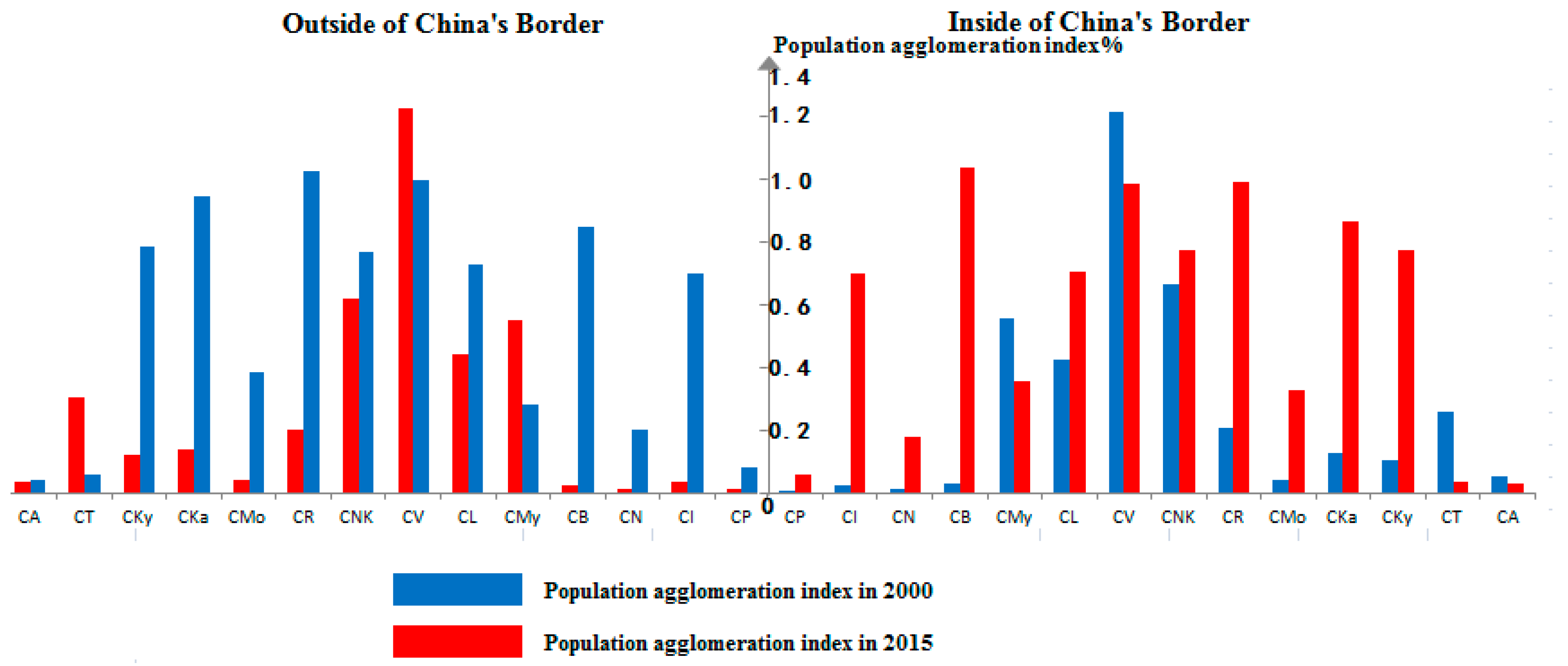
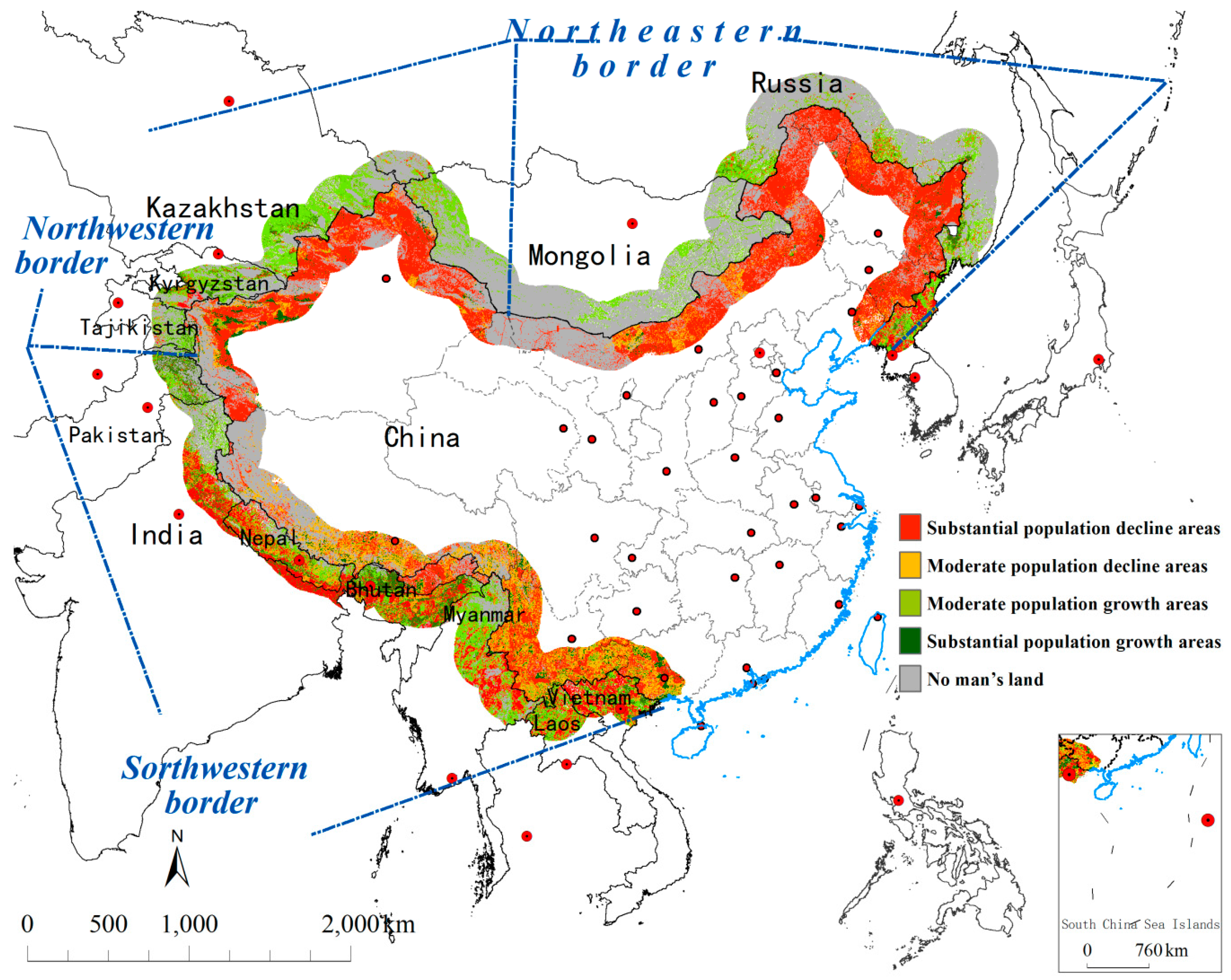
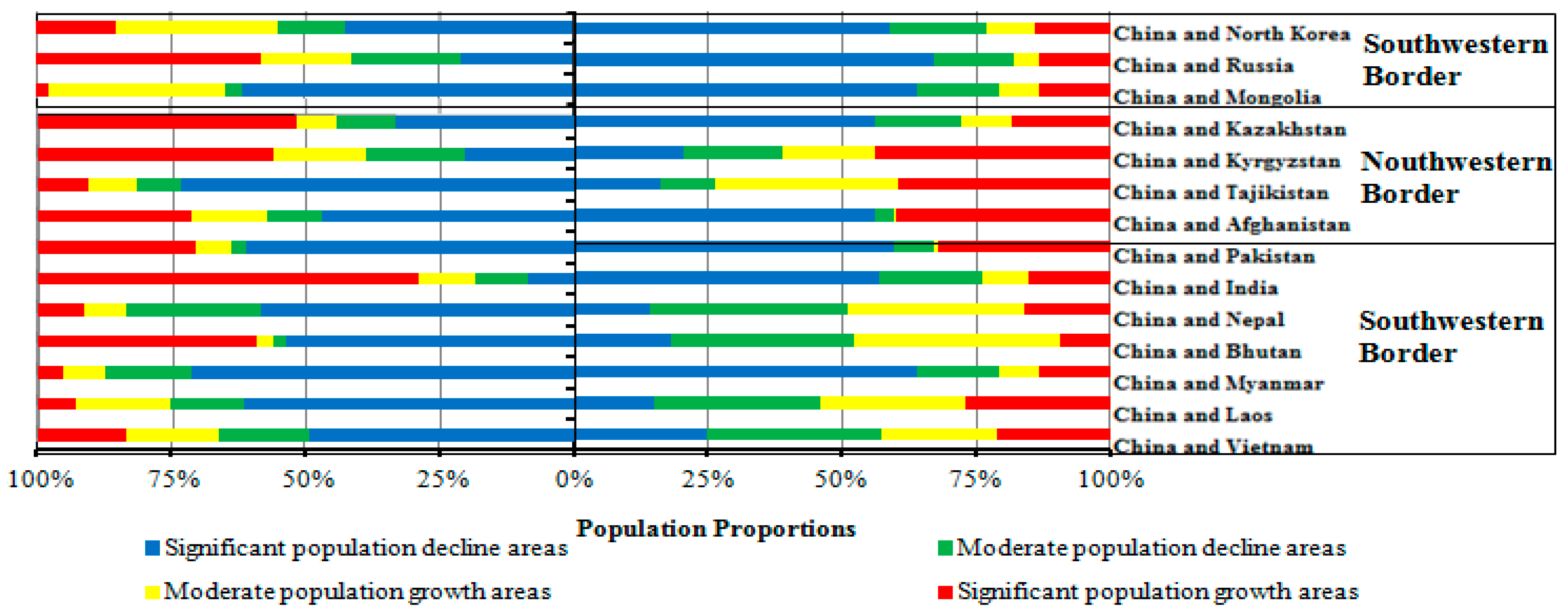
| Border | Type of Population Change | Population | Land | Changes in Population from 2000 to 2015 | |||||
|---|---|---|---|---|---|---|---|---|---|
| Total (10,000) | Proportion (%) | Areas (104 km2) | Proportion (%) | Changes in Total (10,000) | Proportion (%) | ||||
| Inside China’s border | Population decline areas | Substantial population decline areas | 3039.68 | 33.6 | 37.95 | 9.29 | 1897.84 | 1757.89 | 92.63 |
| Moderate population decline areas | 201.03 | 2.22 | 78.49 | 19.21 | 139.95 | 7.37 | |||
| Population growth areas | Moderate population growth areas | 3524.77 | 38.97 | 49.42 | 12.1 | 2584.31 | 718.85 | 27.82 | |
| Substantial population growth areas | 2279.95 | 25.21 | 7.34 | 1.8 | 1865.46 | 72.18 | |||
| No man’s land | / | 235.3 | 57.6 | ||||||
| Outside China’s border | Population decline areas | Substantial population decline areas | 4457.54 | 22.26 | 27.12 | 6.01 | 3418.14 | 3342.59 | 97.79 |
| Moderate population decline areas | 222.26 | 1.11 | 42.56 | 9.42 | 75.55 | 2.21 | |||
| Population growth areas | Moderate population growth areas | 269.4 | 1.35 | 43.74 | 9.69 | 6961.04 | 32.89 | 0.47 | |
| Substantial population growth areas | 15,076.49 | 75.29 | 38.15 | 8.45 | 6928.15 | 99.53 | |||
| No man’s land | / | 300.08 | 66.44 | ||||||
© 2017 by the authors. Licensee MDPI, Basel, Switzerland. This article is an open access article distributed under the terms and conditions of the Creative Commons Attribution (CC BY) license ( http://creativecommons.org/licenses/by/4.0/).
Share and Cite
You, Z.; Feng, Z.; Lei, Y.; Yang, Y.; Li, F. Regional Features and National Differences in Population Distribution in China’s Border Regions (2000–2015). Sustainability 2017, 9, 336. https://doi.org/10.3390/su9030336
You Z, Feng Z, Lei Y, Yang Y, Li F. Regional Features and National Differences in Population Distribution in China’s Border Regions (2000–2015). Sustainability. 2017; 9(3):336. https://doi.org/10.3390/su9030336
Chicago/Turabian StyleYou, Zhen, Zhiming Feng, Yalin Lei, Yanzhao Yang, and Fangzhou Li. 2017. "Regional Features and National Differences in Population Distribution in China’s Border Regions (2000–2015)" Sustainability 9, no. 3: 336. https://doi.org/10.3390/su9030336





